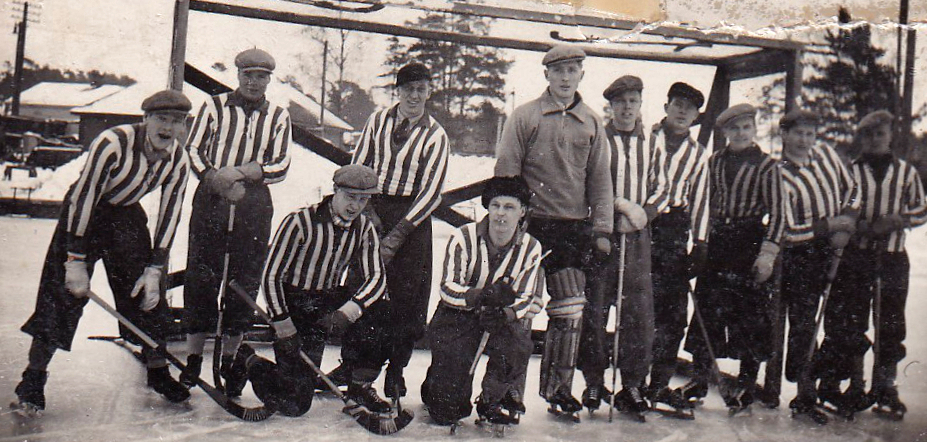Theokritos
Global Moderator
- Apr 6, 2010
- 12,541
- 4,938
In this thread short video clips from the early days of Soviet hockey will be presented, starting in the post-war years and proceeding in chronological order. Comments are welcome.
All newspaper quotes sourced from ice-hockey-stat.com unless noted otherwise.
1945-1946
1946, Feb.24: CDSA Moscow - Krylya Sovietov Moscow 2-0 (bandy)
1946-1947
1946, Dec.22: Dinamo Riga - Dinamo & Kalev Tallinn 5-1
1947, Jan.25: Spartak Moscow - CDKA Moscow 2-0
1947, Jan.26: Dinamo Moscow - CDKA Moscow 2-1
1947-1918
1947, Dec.17: CDKA Moscow - Dinamo Moscow 3-3
1948, Jan.7: Dinamo Riga -Dinamo Moscow 4-1
1948, Feb.17: VVS Moscow - Dinamo Moscow 1-1
1948, Feb.26: Moscow Selects - LTC Prague 6-3
1948-1949
1948, Dec.12: Dinamo Moscow - Spartak Moscow 3-2
1949, Feb.12: CDKA Moscow - Spartak Moscow 9-2
1949, Feb.16: CDKA Moscow - Dinamo Moscow 7-2
1949-1950
1949, Dec.4: CDKA Moscow - Spartak Moscow 3-2
1950-1951
1950, Dec.18: CDKA Moscow - Dinamo Leningrad 11-3
1951, Jan.23: VVS Moscow - CDKA Moscow 5-1
1951, Apr.22: East Germany - Soviet Union 2-21
1951-1952
1952, Jan.24: VVS Moscow - CDSA Moscow 3-2
1952-1953
1953, March 20: Norway - Soviet Union 2-10
1953-1954
1953, Dec.29: Dinamo Moscow - AIK Solna 4-0
1954, Feb.7: Krylya Sovietov Moscow - Nacka SK 10-1
1954, Feb.12: Soviet Union - Czechoslovakia 3-5
1954, Feb.14: Soviet Union - Czechoslovakia 2-0
1954, Feb.16: Soviet Union - Switzerland 13-1
1954, Feb.26: Soviet Union - Finland 7-1
1954, Mar.1: Soviet Union - West Germany 6-2
1954, Mar.2: Soviet Union - Czechoslovakia 5-2
1954, Mar.5: Soviet Union - Sweden 1-1
1954, Mar.7: Soviet Union - Canada 7-2
1954-1955
1954, Oct.23: Soviet Union ("Dinamo Moscow") - Krefelder EV 7-0
1954, Nov.: Dinamo Moscow training session
1955, Jan.7: Soviet Union - Sweden 4-2
1955, Jan.12: Soviet Union - Czechoslovakia 3-0
1955, Feb.26: Soviet Union - Sweden 2-1
1955, Mar.2: Soviet Union - United States 3-0
1955, Mar.6: Soviet Union - Canada 0-5
1955-1956
1955, Nov.27: EC Bad Tölz & SC Riessersse - Soviet Union B 1-7
1955, December 3: Brighton Tigers - Soviet Union 1-2
1955, December 12: Soviet Union - Harringay Racers 7-1
1955, December 15: Soviet Union - Harringay Racers 4-0
1955, December 17: Soviet Union - Switzerland 11-1
All newspaper quotes sourced from ice-hockey-stat.com unless noted otherwise.
1945-1946
1946, Feb.24: CDSA Moscow - Krylya Sovietov Moscow 2-0 (bandy)
1946-1947
1946, Dec.22: Dinamo Riga - Dinamo & Kalev Tallinn 5-1
1947, Jan.25: Spartak Moscow - CDKA Moscow 2-0
1947, Jan.26: Dinamo Moscow - CDKA Moscow 2-1
1947-1918
1947, Dec.17: CDKA Moscow - Dinamo Moscow 3-3
1948, Jan.7: Dinamo Riga -Dinamo Moscow 4-1
1948, Feb.17: VVS Moscow - Dinamo Moscow 1-1
1948, Feb.26: Moscow Selects - LTC Prague 6-3
1948-1949
1948, Dec.12: Dinamo Moscow - Spartak Moscow 3-2
1949, Feb.12: CDKA Moscow - Spartak Moscow 9-2
1949, Feb.16: CDKA Moscow - Dinamo Moscow 7-2
1949-1950
1949, Dec.4: CDKA Moscow - Spartak Moscow 3-2
1950-1951
1950, Dec.18: CDKA Moscow - Dinamo Leningrad 11-3
1951, Jan.23: VVS Moscow - CDKA Moscow 5-1
1951, Apr.22: East Germany - Soviet Union 2-21
1951-1952
1952, Jan.24: VVS Moscow - CDSA Moscow 3-2
1952-1953
1953, March 20: Norway - Soviet Union 2-10
1953-1954
1953, Dec.29: Dinamo Moscow - AIK Solna 4-0
1954, Feb.7: Krylya Sovietov Moscow - Nacka SK 10-1
1954, Feb.12: Soviet Union - Czechoslovakia 3-5
1954, Feb.14: Soviet Union - Czechoslovakia 2-0
1954, Feb.16: Soviet Union - Switzerland 13-1
1954, Feb.26: Soviet Union - Finland 7-1
1954, Mar.1: Soviet Union - West Germany 6-2
1954, Mar.2: Soviet Union - Czechoslovakia 5-2
1954, Mar.5: Soviet Union - Sweden 1-1
1954, Mar.7: Soviet Union - Canada 7-2
1954-1955
1954, Oct.23: Soviet Union ("Dinamo Moscow") - Krefelder EV 7-0
1954, Nov.: Dinamo Moscow training session
1955, Jan.7: Soviet Union - Sweden 4-2
1955, Jan.12: Soviet Union - Czechoslovakia 3-0
1955, Feb.26: Soviet Union - Sweden 2-1
1955, Mar.2: Soviet Union - United States 3-0
1955, Mar.6: Soviet Union - Canada 0-5
1955-1956
1955, Nov.27: EC Bad Tölz & SC Riessersse - Soviet Union B 1-7
1955, December 3: Brighton Tigers - Soviet Union 1-2
1955, December 12: Soviet Union - Harringay Racers 7-1
1955, December 15: Soviet Union - Harringay Racers 4-0
1955, December 17: Soviet Union - Switzerland 11-1
Last edited:



